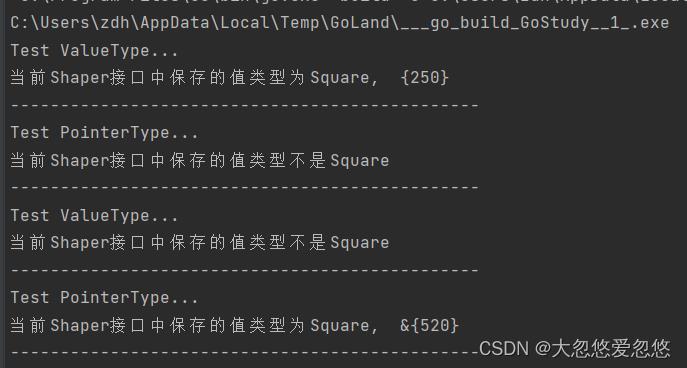GoLang接口---中
Posted 大忽悠爱忽悠
tags:
篇首语:本文由小常识网(cha138.com)小编为大家整理,主要介绍了GoLang接口---中相关的知识,希望对你有一定的参考价值。
GoLang接口---中
引言
上一篇文章中,我们对接口的基本使用和底层实现做了简单的了解,本文对接口的一些使用技巧做相关陈述。
接口的类型断言
一个接口类型的变量 varI 中可以包含任何类型的值,必须有一种方式来检测它的 动态 类型,即运行时在变量中存储的值的实际类型。

func main()
var shaper Shaper
if rand.Intn(10) > 5
shaper = Circleradius: 12.1
else
shaper = Squareside: 12.1
println(shaper)
显然,上面这段程序,只有在运行时才能确定shaper接口中存储的值的类型
那么,有没有什么方法可以来判断当前shaper接口中存储的值的类型到底是什么呢?
通常我们可以使用 类型断言 来测试在某个时刻 varI 是否包含类型 T 的值:
v := varI.(T) // unchecked type assertion
varI 必须是一个接口变量,否则编译器会报错:
invalid type assertion: varI.(T) (non-interface type (type of varI) on left) 。
类型断言可能是无效的,虽然编译器会尽力检查转换是否有效,但是它不可能预见所有的可能性。如果转换在程序运行时失败会导致错误发生。更安全的方式是使用以下形式来进行类型断言:
if v, ok := varI.(T); ok // checked type assertion
Process(v)
return
// varI is not of type T
如果转换合法,v 是 varI 转换到类型 T 的值,ok 会是 true;否则 v 是类型 T 的零值,ok 是 false,也没有运行时错误发生。

这里 接口变量.(接口实现类的类型) 的操作可以理解为将父类类型强制转换为子类类型后返回,但是转换的前提是,实现类必须实现了当前接口的所有方法才行,否则go编译会报错
实例演示
package main
import (
"fmt"
)
type Square struct
side float32
func (sq Square) Area() float32
return sq.side * sq.side
type Shaper interface
Area() float32
func main()
var shaper Shaper
//调用方法为结构体---此时接口中保存的值类型为结构体
shaper = Squareside: 250
testValueType(shaper)
testPointerType(shaper)
//调用方为指针--此时接口中保存的值类型为指针
shaper = &Squareside: 520
testValueType(shaper)
testPointerType(shaper)
func testValueType(shaper Shaper)
println("Test ValueType...")
//判断接口中保存的值类型是否为结构体
if square, ok := shaper.(Square); ok
fmt.Println("当前Shaper接口中保存的值类型为Square, ", square)
else
fmt.Println("当前Shaper接口中保存的值类型不是Square")
fmt.Println("-----------------------------------------------")
func testPointerType(shaper Shaper)
println("Test PointerType...")
//判断接口中保存的值类型是否为指针
if square, ok := shaper.(*Square); ok
fmt.Println("当前Shaper接口中保存的值类型为Square, ", square)
else
fmt.Println("当前Shaper接口中保存的值类型不是Square")
fmt.Println("-----------------------------------------------")

打印输出结果的具体原因,可以参考下面这幅图思考:

因为对于接口而言,当方法接受者为指针时,只有指针才能调用该方法,因此如果将上面的例子改一下:
package main
import (
"fmt"
)
type Square struct
side float32
//方法接受者为指针,只有指针实现才能调用该方法
func (sq *Square) Area() float32
return sq.side * sq.side
type Shaper interface
Area() float32
func main()
var shaper Shaper
//这里就无法结构体实现的Square就没有实现Shaper接口了
//shaper = Squareside: 250
//
//testValueType(shaper)
//testPointerType(shaper)
shaper = &Squareside: 520
//testValueType(shaper)
testPointerType(shaper)
//func testValueType(shaper Shaper)
// println("Test ValueType...")
//这里Square结构体并没有实现Shaper接口,因此不能直接这样进行强制类型转换
// if square, ok := shaper.(Square); ok
// fmt.Println("当前Shaper接口中保存的值类型为Square, ", square)
// else
// fmt.Println("当前Shaper接口中保存的值类型不是Square")
//
//
// fmt.Println("-----------------------------------------------")
//
func testPointerType(shaper Shaper)
println("Test PointerType...")
if square, ok := shaper.(*Square); ok
fmt.Println("当前Shaper接口中保存的值类型为Square, ", square)
else
fmt.Println("当前Shaper接口中保存的值类型不是Square")
fmt.Println("-----------------------------------------------")

类型判断:type-switch
接口变量的类型也可以使用一种特殊形式的 switch 来检测:type-switch
switch t := areaIntf.(type)
case *Square:
fmt.Printf("Type Square %T with value %v\\n", t, t)
case *Circle:
fmt.Printf("Type Circle %T with value %v\\n", t, t)
case nil:
fmt.Printf("nil value: nothing to check?\\n")
default:
fmt.Printf("Unexpected type %T\\n", t)
变量 t 得到了 areaIntf 的值和类型, 所有 case 语句中列举的类型(nil 除外)都必须实现对应的接口(在上例中即 Shaper),如果被检测类型没有在 case 语句列举的类型中,就会执行 default 语句。
可以用 type-switch 进行运行时类型分析,但是在 type-switch 不允许有 fallthrough 。
如果仅仅是测试变量的类型,不用它的值,那么就可以不需要赋值语句,比如:
switch areaIntf.(type)
case *Square:
// TODO
case *Circle:
// TODO
...
default:
// TODO
nil 和 non-nil
我们可以通过一个例子理解『Go 语言的接口类型不是任意类型』这一句话,下面的代码在 main 函数中初始化了一个 *TestStruct 结构体指针,由于指针的零值是 nil,所以变量 s 在初始化之后也是 nil:
package main
type TestStruct struct
func NilOrNot(v interface) bool
return v == nil
func main()
var s *TestStruct
fmt.Println(s == nil) // #=> true
fmt.Println(NilOrNot(s)) // #=> false
$ go run main.go
true
false
我们简单总结一下上述代码执行的结果:
- 将上述变量与 nil 比较会返回 true;
- 将上述变量传入 NilOrNot 方法并与 nil 比较会返回 false;
出现上述现象的原因是调用 NilOrNot 函数时发生了隐式的类型转换,除了向方法传入参数之外,变量的赋值也会触发隐式类型转换。在类型转换时,*TestStruct 类型会转换成 interface 类型,转换后的变量不仅包含转换前的变量,还包含变量的类型信息 TestStruct,所以转换后的变量与 nil 不相等。
空接口
空接口或者最小接口 不包含任何方法,它对实现不做任何要求:
type Any interface
任何其他类型都实现了空接口(它不仅仅像 Java/C# 中 Object 引用类型),any 或 Any 是空接口一个很好的别名或缩写。
空接口类似 Java/C# 中所有类的基类: Object 类,二者的目标也很相近。
可以给一个空接口类型的变量 var val interface 赋任何类型的值。
示例:
package main
import "fmt"
var i = 5
var str = "ABC"
type Person struct
name string
age int
type Any interface
func main()
var val Any
val = 5
fmt.Printf("val has the value: %v\\n", val)
val = str
fmt.Printf("val has the value: %v\\n", val)
pers1 := new(Person)
pers1.name = "Rob Pike"
pers1.age = 55
val = pers1
fmt.Printf("val has the value: %v\\n", val)
switch t := val.(type)
case int:
fmt.Printf("Type int %T\\n", t)
case string:
fmt.Printf("Type string %T\\n", t)
case bool:
fmt.Printf("Type boolean %T\\n", t)
case *Person:
fmt.Printf("Type pointer to Person %T\\n", t)
default:
fmt.Printf("Unexpected type %T", t)
输出:
val has the value: 5
val has the value: ABC
val has the value: &Rob Pike 55
Type pointer to Person *main.Person
在上面的例子中,接口变量 val 被依次赋予一个 int,string 和 Person 实例的值,然后使用 type-switch 来测试它的实际类型。每个 interface 变量在内存中占据两个字长:一个用来存储它包含的类型,另一个用来存储它包含的数据或者指向数据的指针。
构建通用类型或包含不同类型变量的数组
通过使用空接口。让我们给空接口定一个别名类型 Element:type Element interface
然后定义一个容器类型的结构体 Vector,它包含一个 Element 类型元素的切片:
type Vector struct
a []Element
Vector 里能放任何类型的变量,因为任何类型都实现了空接口,实际上 Vector 里放的每个元素可以是不同类型的变量。我们为它定义一个 At() 方法用于返回第 i 个元素:
func (p *Vector) At(i int) Element
return p.a[i]
再定一个 Set() 方法用于设置第 i 个元素的值:
func (p *Vector) Set(i int, e Element)
p.a[i] = e
Vector 中存储的所有元素都是 Element 类型,要得到它们的原始类型(unboxing:拆箱)需要用到类型断言。
TODO:The compiler rejects assertions guaranteed to fail,类型断言总是在运行时才执行,因此它会产生运行时错误。
复制数据切片至空接口切片
假设你有一个 myType 类型的数据切片,你想将切片中的数据复制到一个空接口切片中,类似:
var dataSlice []myType = FuncReturnSlice()
var interfaceSlice []interface = dataSlice
可惜不能这么做,编译时会出错:cannot use dataSlice (type []myType) as type []interface in assignment。
原因是它们俩在内存中的布局是不一样的。
必须使用 for-range 语句来一个一个显式地赋值:
var dataSlice []myType = FuncReturnSlice()
var interfaceSlice []interface = make([]interface, len(dataSlice))
for i, d := range dataSlice
interfaceSlice[i] = d
通用类型的节点数据结构
诸如列表和树这样的数据结构,在它们的定义中使用了一种叫节点的递归结构体类型,节点包含一个某种类型的数据字段。现在可以使用空接口作为数据字段的类型,这样我们就能写出通用的代码。下面是实现一个二叉树的部分代码:通用定义、用于创建空节点的 NewNode 方法,及设置数据的 SetData 方法。
package main
import "fmt"
type Node struct
le *Node
data interface
ri *Node
func NewNode(left, right *Node) *Node
return &Nodeleft, nil, right
func (n *Node) SetData(data interface)
n.data = data
func main()
root := NewNode(nil, nil)
root.SetData("root node")
// make child (leaf) nodes:
a := NewNode(nil, nil)
a.SetData("left node")
b := NewNode(nil, nil)
b.SetData("right node")
root.le = a
root.ri = b
fmt.Printf("%v\\n", root) // Output: &0x125275f0 root node 0x125275e0
接口到接口
一个接口的值可以赋值给另一个接口变量,只要底层类型实现了必要的方法。这个转换是在运行时进行检查的,转换失败会导致一个运行时错误:这是 Go 语言动态的一面,可以拿它和 Ruby 和 Python 这些动态语言相比较。
假定:
var ai AbsInterface // declares method Abs()
type SqrInterface interface
Sqr() float
var si SqrInterface
pp := new(Point) // say *Point implements Abs, Sqr
var empty interface
那么下面的语句和类型断言是合法的:
empty = pp // everything satisfies empty
ai = empty.(AbsInterface) // underlying value pp implements Abs()
// (runtime failure otherwise)
si = ai.(SqrInterface) // *Point has Sqr() even though AbsInterface doesn’t
empty = si // *Point implements empty set
// Note: statically checkable so type assertion not necessary.
下面是函数调用的一个例子:
type myPrintInterface interface
print()
func f3(x myInterface)
x.(myPrintInterface).print() // type assertion to myPrintInterface
x 转换为 myPrintInterface 类型是完全动态的:只要 x 的底层类型(动态类型)定义了 print 方法这个调用就可以正常运行
参考
- Go入门指南
- Go语言设计与实现
以上是关于GoLang接口---中的主要内容,如果未能解决你的问题,请参考以下文章